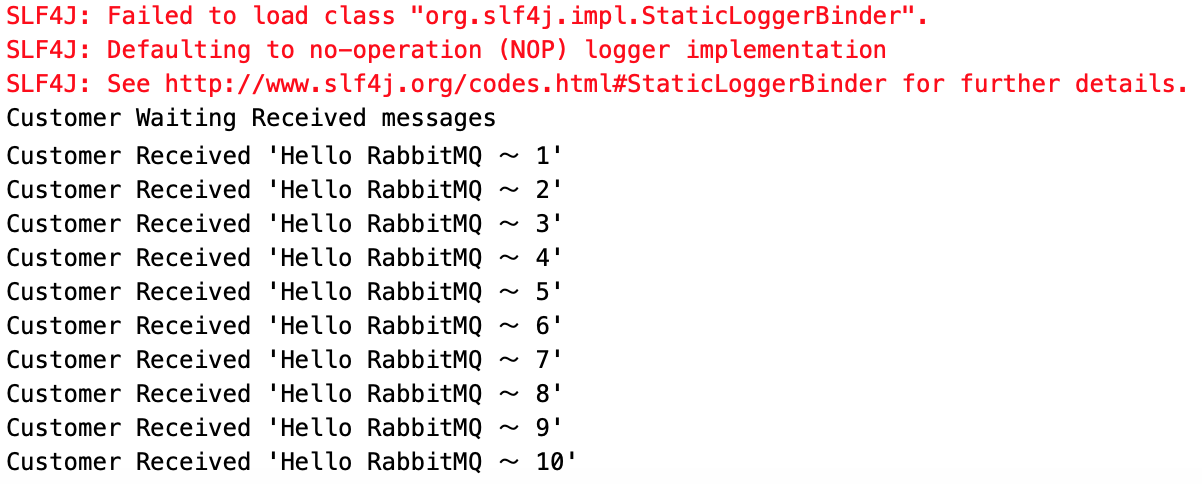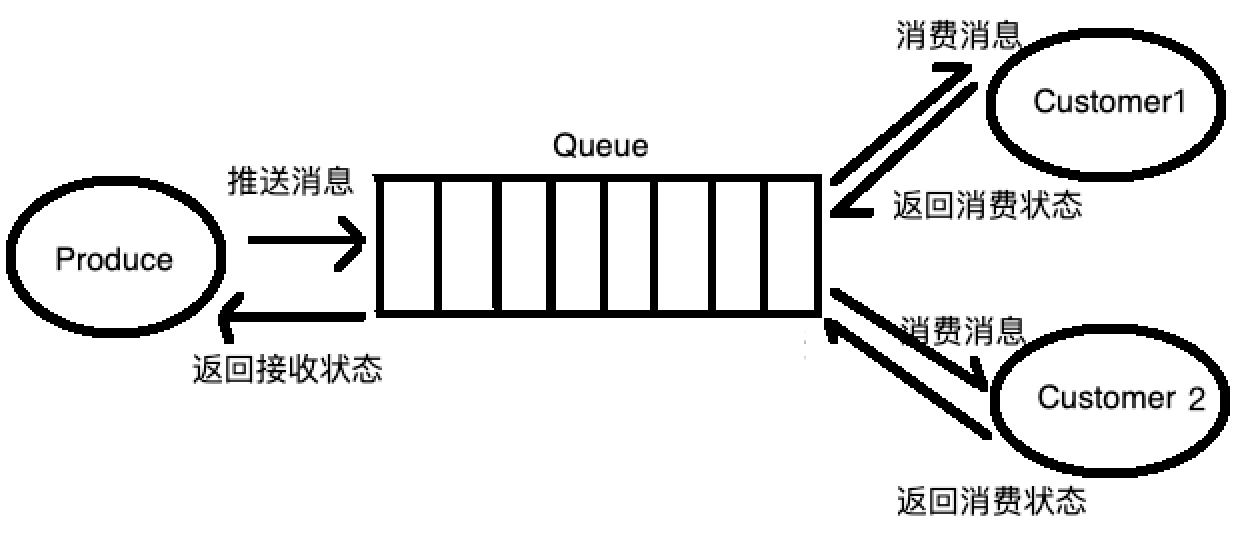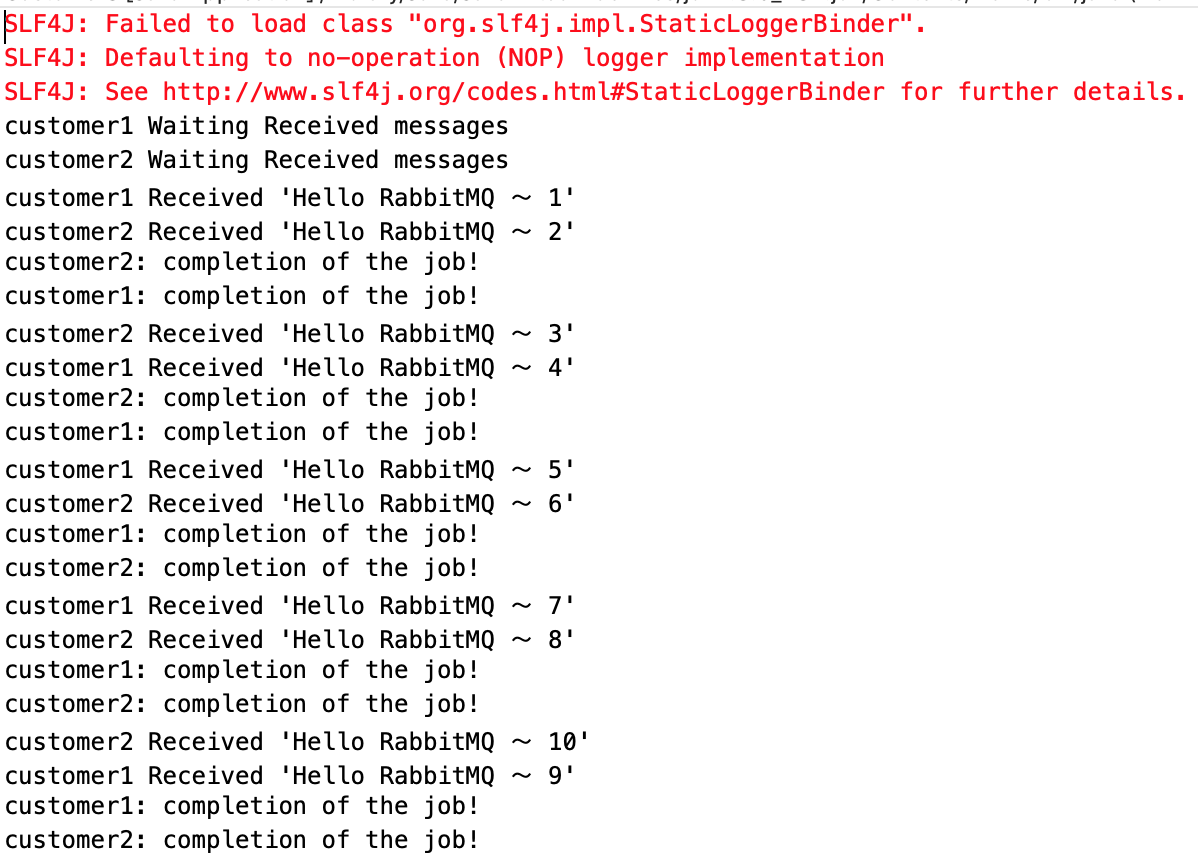准备工作
1、安装RabbitMQ,参考【RabbitMQ】 RabbitMQ安装
2、新建Java项目,引入RabbitMQ的Maven依赖
1 <dependency> 2 <groupId>com.rabbitmq</groupId> 3 <artifactId>amqp-client</artifactId> 4 <version>5.5.0</version> 5 </dependency>
单生产者消费者
流程图:

1、创建生产者Producer1
1 public class Producer1 { 2 3 private final static String QUEUE_NAME = "rabbitMQ.test.queue"; 4 5 public static void main(String[] args) throws IOException, TimeoutException { 6 7 // 创建连接工厂 8 ConnectionFactory factory = new ConnectionFactory(); 9 // 设置RabbitMQ相关信息 10 factory.setHost("localhost"); 11 factory.setUsername("guest"); 12 factory.setPassword("guest"); 13 factory.setPort(5672); 14 // 创建一个新的连接 15 Connection connection = factory.newConnection(); 16 // 创建一个通道 17 Channel channel = connection.createChannel(); 18 19 // 声明一个队列 20 // queueDeclare(队列名称,是否持久化(true表示是,队列将在服务器重启时生存),是否是独占队列(创建者可以使用的私有队列,断开后自动删除), 21 // 当所有消费者客户端连接断开时是否自动删除队列,队列的其他参数) 22 channel.queueDeclare(QUEUE_NAME, false, false, false, null); 23 String message = "Hello RabbitMQ ~"; 24 25 // 发送消息到队列中 26 // basicPublish(交换机名称,队列映射的路由key,消息的其他属性,发送信息的主体) 27 channel.basicPublish("", QUEUE_NAME, null, message.getBytes("UTF-8")); 28 System.out.println("Producer Send +'" + message + "'"); 29 // 关闭通道和连接 30 channel.close(); 31 connection.close(); 32 33 } 34 35 }
2、创建消费者Customer1
1 public class Customer1 { 2 3 private final static String QUEUE_NAME = "rabbitMQ.test.queue"; 4 5 public static void main(String[] args) throws IOException, TimeoutException { 6 // 创建连接工厂 7 ConnectionFactory factory = new ConnectionFactory(); 8 // 设置RabbitMQ地址 9 factory.setHost("localhost"); 10 factory.setUsername("guest"); 11 factory.setPassword("guest"); 12 factory.setPort(5672); 13 // 创建一个新的连接 14 Connection connection = factory.newConnection(); 15 // 创建一个通道 16 final Channel channel = connection.createChannel(); 17 // 声明要关注的队列 18 channel.queueDeclare(QUEUE_NAME, false, false, false, null); 19 channel.basicQos(1);//保证一次只分发一个 20 System.out.println("Customer Waiting Received messages"); 21 22 // DefaultConsumer类实现了Consumer接口,通过传入一个频道, 23 // 告诉服务器我们需要那个频道的消息,如果频道中有消息,就会执行回调函数handleDelivery 24 Consumer consumer = new DefaultConsumer(channel) { 25 @Override 26 public void handleDelivery(String consumerTag, Envelope envelope, AMQP.BasicProperties properties, 27 byte[] body) throws IOException { 28 String message = new String(body, "UTF-8"); 29 System.out.println("Customer Received '" + message + "'"); 30 } 31 }; 32 33 // 自动回复队列应答 -- RabbitMQ中的消息确认机制 34 channel.basicConsume(QUEUE_NAME, true, consumer); 35 } 36 37 }
3、运行结果
a、生产者

b、消费者

推送确认和消费应答
流程图

1、创建推送确认生产者Producer2
1 public class Producer2 { 2 3 private final static String QUEUE_NAME = "rabbitMQ.test.queue"; 4 5 public static void main(String[] args) throws IOException, TimeoutException { 6 7 // 创建连接工厂 8 ConnectionFactory factory = new ConnectionFactory(); 9 // 设置RabbitMQ相关信息 10 factory.setHost("localhost"); 11 factory.setUsername("guest"); 12 factory.setPassword("guest"); 13 factory.setPort(5672); 14 // 创建一个新的连接 15 Connection connection = factory.newConnection(); 16 // 创建一个通道 17 Channel channel = connection.createChannel(); 18 19 // 声明一个队列 20 // queueDeclare(队列名称,是否持久化(true表示是,队列将在服务器重启时生存),是否是独占队列(创建者可以使用的私有队列,断开后自动删除), 21 // 当所有消费者客户端连接断开时是否自动删除队列,队列的其他参数) 22 channel.queueDeclare(QUEUE_NAME, false, false, false, null); 23 24 // 开启发送方确认模式 25 channel.confirmSelect(); 26 27 // 存储未确认的消息标识tag 28 final SortedSet<Long> confirmSet = Collections.synchronizedNavigableSet(new TreeSet<Long>()); 29 30 // 异步监听确认和未确认的消息 31 channel.addConfirmListener(new ConfirmListener() { 32 33 /** 34 * 处理返回确认成功 35 * 36 * @param deliveryTag 如果是多条,这个就是最后一条消息的tag 37 * @param multiple 是否多条 38 * @throws IOException 39 */ 40 public void handleAck(long deliveryTag, boolean multiple) throws IOException { 41 System.out.println("消息发送成功, deliveryTag:" + deliveryTag + " multiple:" + multiple + ""); 42 if (multiple) { 43 // 移除发送成功的多条消息标识tag 44 confirmSet.headSet(deliveryTag + 1).clear(); 45 } else { 46 // 移除发送成功的一条消息标识tag 47 confirmSet.remove(deliveryTag); 48 } 49 } 50 51 /** 52 * 处理返回确认失败 53 * 54 * @param deliveryTag 如果是多条,这个就是最后一条消息的tag 55 * @param multiple 是否多条 56 * @throws IOException 57 */ 58 public void handleNack(long deliveryTag, boolean multiple) throws IOException { 59 System.out.println("失败,deliveryTag:" + deliveryTag + "multiple:" + multiple + ""); 60 if (multiple) { 61 confirmSet.headSet(deliveryTag + 1).clear(); 62 } else { 63 confirmSet.remove(deliveryTag); 64 } 65 } 66 67 }); 68 69 String message = "Hello RabbitMQ ~ "; 70 71 // 发送消息到队列中 72 // basicPublish(交换机名称,队列映射的路由key,消息的其他属性,发送信息的主体) 73 for (int i = 1; i <= 10; i++) { 74 String msg = message + i; 75 long tag = channel.getNextPublishSeqNo(); 76 confirmSet.add(tag); 77 System.out.println("tag:" + tag); 78 79 channel.basicPublish("", QUEUE_NAME, null, msg.getBytes("UTF-8")); 80 System.out.println("Producer Send +'" + msg + "'"); 81 82 } 83 84 System.out.println("============================"); 85 // 关闭通道和连接 86 // channel.close(); 87 // connection.close(); 88 89 } 90 }
2、创建消费应答消费者Customer2
1 public class Customer2 { 2 3 private final static String QUEUE_NAME = "rabbitMQ.test.queue"; 4 5 public static void main(String[] args) throws IOException, TimeoutException { 6 // 创建连接工厂 7 ConnectionFactory factory = new ConnectionFactory(); 8 // 设置RabbitMQ地址 9 factory.setHost("localhost"); 10 factory.setUsername("guest"); 11 factory.setPassword("guest"); 12 factory.setPort(5672); 13 // 创建一个新的连接 14 Connection connection = factory.newConnection(); 15 // 创建一个通道 16 final Channel channel = connection.createChannel(); 17 // 声明要关注的队列 18 channel.queueDeclare(QUEUE_NAME, false, false, false, null); 19 channel.basicQos(1);// 保证一次只分发一个 20 System.out.println("Customer Waiting Received messages"); 21 22 // DefaultConsumer类实现了Consumer接口,通过传入一个频道, 23 // 告诉服务器我们需要那个频道的消息,如果频道中有消息,就会执行回调函数handleDelivery 24 Consumer consumer = new DefaultConsumer(channel) { 25 @Override 26 public void handleDelivery(String consumerTag, Envelope envelope, AMQP.BasicProperties properties, 27 byte[] body) throws IOException { 28 String message = new String(body, "UTF-8"); 29 System.out.println("Customer Received '" + message + "'"); 30 31 // 返回消费确认状态 32 channel.basicAck(envelope.getDeliveryTag(), false); 33 } 34 }; 35 36 // 消费手动确认 -- RabbitMQ中的消息确认机制 37 channel.basicConsume(QUEUE_NAME, false, consumer); 38 } 39 40 }
3、运行结果
生产者:

消费者:

多消费者
流程图

1、创建推送确认生产者Producer3(与示例Producer2一样)
2、创建消费应答消费者Customer3
1 public class Customer3 { 2 3 private final static String QUEUE_NAME = "rabbitMQ.test.queue"; 4 5 public static void main(String[] args) throws IOException, TimeoutException { 6 Customer3 customer3 = new Customer3(); 7 customer3.createCustomer("customer1"); 8 customer3.createCustomer("customer2"); 9 } 10 11 public void createCustomer(final String customerName) throws IOException, TimeoutException{ 12 13 // 创建连接工厂 14 ConnectionFactory factory = new ConnectionFactory(); 15 // 设置RabbitMQ地址 16 factory.setHost("localhost"); 17 factory.setUsername("guest"); 18 factory.setPassword("guest"); 19 factory.setPort(5672); 20 // 创建一个新的连接 21 Connection connection = factory.newConnection(); 22 // 创建一个通道 23 final Channel channel = connection.createChannel(); 24 // 声明要关注的队列 25 channel.queueDeclare(QUEUE_NAME, false, false, false, null); 26 channel.basicQos(1);// 保证一次只分发一个 27 System.out.println(customerName + " Waiting Received messages"); 28 29 // DefaultConsumer类实现了Consumer接口,通过传入一个频道, 30 // 告诉服务器我们需要那个频道的消息,如果频道中有消息,就会执行回调函数handleDelivery 31 Consumer consumer = new DefaultConsumer(channel) { 32 @Override 33 public void handleDelivery(String consumerTag, Envelope envelope, AMQP.BasicProperties properties, 34 byte[] body) throws IOException { 35 String message = new String(body, "UTF-8"); 36 System.out.println(customerName + " Received '" + message + "'"); 37 38 // doWork处理任务 39 doWork(customerName); 40 41 // 返回消费确认状态 42 channel.basicAck(envelope.getDeliveryTag(), false); 43 } 44 }; 45 46 // 消费手动确认 -- RabbitMQ中的消息确认机制 47 channel.basicConsume(QUEUE_NAME, false, consumer); 48 } 49 50 51 private void doWork(String customer) { 52 try { 53 Thread.sleep(2000); // 暂停2秒钟 54 System.out.println(customer + ": completion of the job!"); 55 } catch (InterruptedException _ignored) { 56 Thread.currentThread().interrupt(); 57 } 58 } 59 }
3、运行结果
生产者与前面相同
消费者
